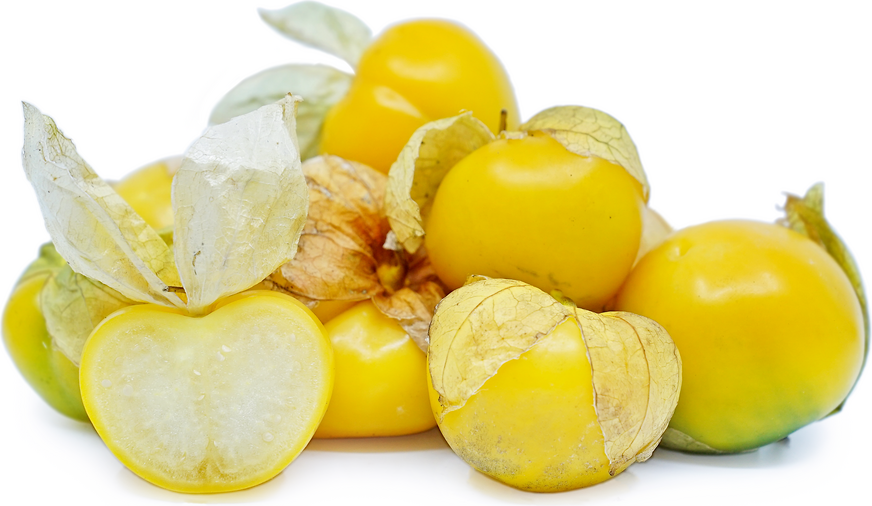


Yellow Tomatillos
Estimated Inventory, 10 lbs : 0
Description/Taste
Yellow tomatillos are small, circular fruits. They average about 4 to 5 centimeters in diameter and have a round, heart shape with a small indentation surrounding their thin, light brown stem. These fruits are covered in a papery tan, outer husk that has a slightly sticky residue on the inside. This husk slides open and fades from green to light brown as it matures, revealing the fruit within. These fruits have vibrant yellow skin with faint hints of bright green at the top of the tomatillo. Their skin is firm, shiny, and can be sliced open to reveal pale yellow-white flesh. This flesh is moist, dense, and filled with small white seeds. Yellow tomatillos are tender, juicy, and crisp. They have a subtly sweet and fruity flavor reminiscent of honeydew melon with notes of acidity.
Seasons/Availability
Yellow tomatillos are available year-round with a peak season from summer to early fall.
Current Facts
Yellow tomatillos, botanically classified as Physalis philadelphica, are small hardy fruits that grow on low, sprawling plants. Despite tomatoes and tomatillos belonging to the same Solanaceae family, tomatillos offer a thicker, meatier consistency and more tangy flavor. Tomatillos are often green but can also develop into shades of purple and yellow. Yellow tomatillos are known for their subtle flavor and are much sweeter than the more common green tomatillo. They produce high yields and can be open-pollinated, which means their seeds will create new plants that are identical to the parent. Tomatillos are a staple ingredient in Mexican cuisine and their name translates to little tomato in Spanish.
Nutritional Value
Like the green variety, Yellow tomatillos are rich in dietary fiber. They aid in digestive health by promoting regular bowel movements and supporting a healthy gut microbiome. These fruits contain a significant amount of vitamin C, boosting the immune system, enhancing collagen production for healthy skin, and improving iron absorption. Vitamin A supports vision, skin health, and immune function, while vitamin K is essential for proper blood clotting and bone health. The niacin content in Yellow tomatillos plays a crucial role in energy metabolism while its potassium helps regulate fluid balance, muscle contractions, and nerve signals, contributing to overall cardiovascular health. This variety is also a source of manganese and magnesium, encouraging bone formation, antioxidant defense, muscle and nerve function, energy production, and maintaining bone density.
Applications
Yellow tomatillos can be prepared in both raw and cooked applications such as sautéing, drying, boiling, or roasting. They're often used in place of green tomatillos to impart a sweeter, less tangy flavor. This variety is frequently incorporated into salsas, guacamoles, jellies, and jams. They bode well for Mexican recipes like enchiladas, pozole, burritos, chile verde, tacos, Huevos Divorciados, quesadillas, and carnitas. Yellow tomatillos can be chopped and cooked in soups, moles, curries, stir-fries, stews, and chowders or simmered with meat dishes for flavoring. Yellow tomatillos pair well with cilantro, onion, garlic, lime, jack cheese, oregano, cumin, cucumbers, olive oil, cabbage, carrots, celery, avocado, meats such as pork, beef, and poultry, rice, and poblano, serrano, jalapeño, and bell peppers. They will keep for up to three weeks when stored in a paper bag with their husks still attached in the crisper drawer of the refrigerator. Yellow tomatillos can also be washed and frozen for extended use.
Ethnic/Cultural Info
Tomatillos existed in the ancient landscape of what is now present-day Argentina. A fossil excavation in the region uncovered evidence of tomatillos dating back to about 52 million years, a time when dinosaurs still roamed the Earth. These fossils were discovered in a lake bed and are believed to have grown in temperate rainforests during a period of significant climatic change on Earth. The discovery of these ancient tomatillos shows that they survived the formation of drastically new habitats, including the formation of the Andes mountains over 25 million years ago. After enduring this transition, tomatillos and the nightshade family they belong to evolved into over 2,400 species, including Yellow tomatillos, tomatoes, red peppers, and potatoes.
Geography/History
Yellow tomatillos, like their green counterparts, are native to Mexico and Central America where the Aztecs first cultivated them as early as 800 BCE. They were spread by Spanish explorers and through trade routes from the New World of modern-day North, Central, and South America to Europe. From there, they made their way to Africa, Australia, and Asia during the mid-1900s. Yellow tomatillos generally thrive in warm, tropical, and subtropical climates with high sun exposure but can also be grown in cooler climates. Similar to the green variety, Yellow tomatillos may be found growing wild in fields, roadsides, and areas with disturbed soils in Mexico and Central America. They are also sown in home gardens or produced commercially on a small scale. Yellow tomatillos are much less common than the green varieties and may be found at some mercados in Mexico and Latin America or at farmers' markets in select areas of the United States like New York City.




